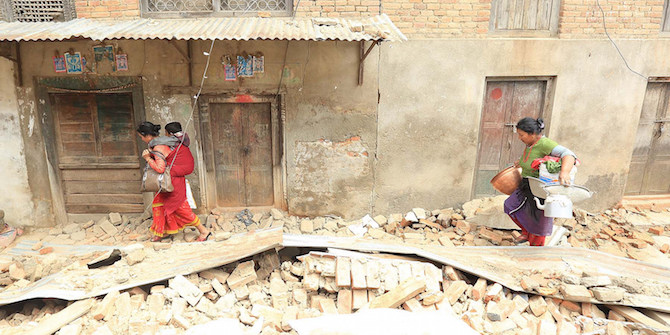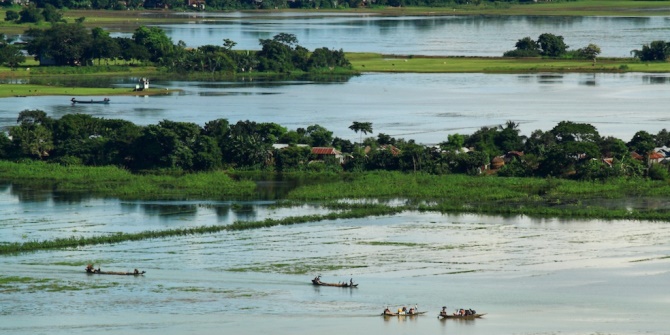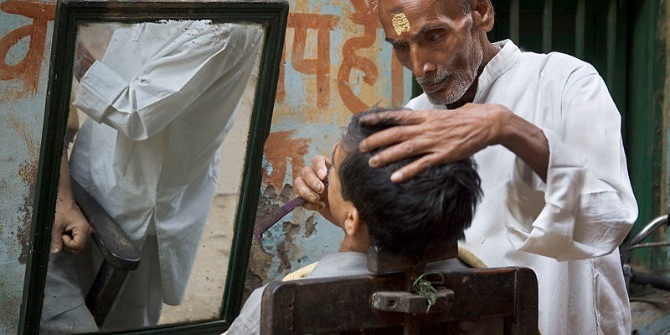 One year on from the devastating earthquakes in Nepal, Sangita Thebe Limbu discusses how the disaster has disproportionately affected women. She highlights how gendered vulnerability is further complicated by other factors such as age, caste and marital status, underlining how pre-existing discriminatory practices and inequalities are being exacerbated and even reinforced in the reconstruction process.
One year on from the devastating earthquakes in Nepal, Sangita Thebe Limbu discusses how the disaster has disproportionately affected women. She highlights how gendered vulnerability is further complicated by other factors such as age, caste and marital status, underlining how pre-existing discriminatory practices and inequalities are being exacerbated and even reinforced in the reconstruction process.
This article forms part of our Nepal Earthquake Anniversary series. Read further posts here.
On 25 April 2015, Nepal was struck by a 7.8 magnitude earthquake, followed by a series of aftershocks including a major one of a 7.3 magnitude on 12 May. Consequently, over 8,790 people lost their lives, 22,300 were injured and an estimated 800,000 houses destroyed or damaged. The earthquakes affected over 8 million people, nearly one-third of the total population of Nepal, in thirty-one out of seventy-five districts. It has been a year since then but the pace of reconstruction process, amidst tumultuous political climate, is yet to gain momentum at a level required to house and support millions of people in need of shelter and secure livelihoods.
Disasters such as earthquakes are natural phenomenon but their impacts are not. Various studies have shown that the impacts of natural disasters are unevenly distributed and in the post-disaster relief and reconstruction phase, pre-existing discriminatory practices and inequalities along the lines of gender, age, caste, class, ethnicity and disability are exacerbated and further reinforced.

Higher female mortality rate during disasters
In their analysis of extensive dataset on natural disasters that occurred between 1981 and 2002 in 141 countries, Eric Neumayer and Thomas Plümper observed that in societies where socio-economic status of women is low, natural disasters directly or indirectly (through related post disaster events) killed more women than men. Likewise, in the aftermath of the 2004 Tsunami, two-thirds of the casualties were identified as females. Following the recent earthquakes in Nepal, more women and girls lost their lives (55 percent) in comparison to men and boys (45 percent).
In the case of 2004 Tsunami, more women and children died as they were inside homes in contrast to men who were out in the open spaces for work. In addition, women and girls being discouraged from physical activities such as running, swimming and climbing trees proved detrimental to their survival. Likewise, the research conducted in disaster prone coastal regions of Bangladesh identified similar social norms and how traditional clothing like sarees hindered women’s swift mobility at the time of disaster.
In the context of Nepal, higher female mortality rate during the earthquakes can be attributed to numerous factors such as male migration to the capital city and abroad and traditional gender roles whereby women and girls were more likely to be inside the house than men. In many cases, women were reported to have delayed their escape to rescue their children, older family members and valuables.
Being a woman in itself does not lead to higher vulnerability. It is the socially constructed gender norms (i.e. assignment of roles, responsibilities and ‘appropriate’ behaviours for woman and man; along with unequal distribution of resources), rather than biological differences, that influence the perceptions of risk and disaster, and creates differential capacities to respond to them.
Equally important is the fact that ‘it is inequities in the everyday, and not just in times of disaster, that creates greater risk and reduces life chances for women and girls.’
Reconceptualisation of ‘disaster’ and ‘risk’
In the DFID review titled Women, Girls and Disasters, Sarah Bradshaw and Maureen Fordham argue that the ‘real’ disaster for women and girls is often the ‘secondary’ impacts felt in the form of intangible changes to their well-being and increased time burden. In addition, ‘disaster risk’ for many women is not just about surviving the actual natural hazard but their well-being is also threatened by human-made risk of violence and abuse.
As one of the earthquake survivors, Kali Tamang, said – “Surviving the earthquake was the easy part, finding shelter and food is much more difficult”. This highlights the difficulties faced in the aftermath also have gender-specific implications. For instance, in makeshift temporary shelters, women and girls face added risks of security, lack of privacy and sanitary facilities. With thousands of health centres and hospitals destroyed, it became especially difficult for pregnant women to access sexual and reproductive healthcare.
Furthermore, disrupted water and electricity supplies mean women and girls are spending more time in search of water and fuel. Only 19.7 percent of land and houses are under female ownership, which makes it difficult for many women to access relief funds directly to re-build their houses. Likewise, women are disproportionately overrepresented in agriculture and low paid jobs in informal sector, so there is an added challenge of securing sustainable livelihood opportunities.
The Post Disaster Need Assessment (PDNA) carried out by the National Planning Commission (NPC), Government of Nepal, has acknowledged gendered impacts of disasters and has identified gender equity and social inclusion as one of the guiding principles of recovery programmes. However, such claims appear rhetorical particularly in a context where only two out of ninety-five members in Central Reconstruction Advisory Council in the National Reconstruction Authority (NRA) are women.
The lack of women’s substantive representation in decision-making bodies has severe consequences in how agendas are shaped and resources allocated. However, even when ‘women’s issues’ and ‘women’s vulnerabilities’ are represented, they are framed within the context of either female-headed households or within an overarching category of ‘women’, which often conflates differences and homogenises intersectional identities and experiences of vulnerabilities.
Power relations and intersecting identities
Disaster sociologist Elaine Enarson argues that gendered vulnerability is derived from intersecting identities and social relationships. This focus on intersectionality (which refers to how experiences of oppressions are shaped through interactions of different power relationships) is important and in the post-disaster reconstruction phase, it should be a key in identifying ‘the most vulnerable groups’ and how resources can be allocated not only to meet their immediate needs but also to address their systemic exclusion.
To give an example, for a Dalit woman, it is not only gender but the simultaneous interaction of gender and caste that shapes her experiences of vulnerability. This can be further exacerbated by other factors such as age and marital status. Likewise, in the Tamang community, one of the most affected groups, the historical marginalisation of the community in general has exacerbated pre-existing vulnerabilities post-disaster. For example, not speaking Nepali has proven to be a barrier for many women in accessing relief.
There is no doubt the earthquakes have affected all social groups; however, the impacts of the earthquakes remain particularly severe for communities who remain historically underrepresented in political, social and economic sphere. To quote Shradha Ghale, vulnerability is ‘a result of the entrenched inequalities of class, caste, and region that have benefited a small section of our society.’ I would add gender to the equation and argue that intersectional identities and differential experiences of vulnerabilities need to be taken into account to make post-disaster reconstruction process inclusive and transformative.
This article forms part of our Nepal Earthquake Anniversary series. Read further posts here.
Note: This article gives the views of the author, and not the position of the South Asia @ LSE blog, nor of the London School of Economics. Please read our comments policy before posting.
About the Author
 Sangita Thebe Limbu is studying Gender, Development and Globalisation at the London School of Economics and Political Science (LSE). She is a regular contributor to South Asia @ LSE, you can view her previous posts here.
Sangita Thebe Limbu is studying Gender, Development and Globalisation at the London School of Economics and Political Science (LSE). She is a regular contributor to South Asia @ LSE, you can view her previous posts here.







